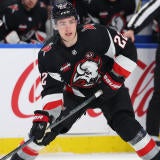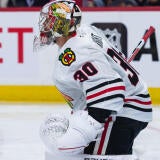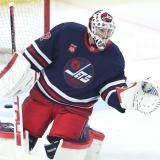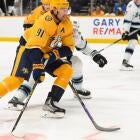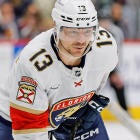Blue Line Buzz: Advanced metrics and waiver targets
Let rivals get stuffed with holiday fare. Jason Chen says it's a good time to get an edge on buying and selling with advanced stats.
Happy holidays!
The Christmas break is almost upon us, with the NHL taking a lengthy break starting Dec. 23 and resuming action the day after Boxing Day on December 27. Oh, Boxing Day? That's the day after Christmas Day, and for Canadians, the biggest shopping day of the year. Things that weren't sold leading up to Christmas can now be had at major discounts.
But what, exactly, does Boxing Day have to do with Fantasy hockey? A lot, actually, because shoppers and poolies are looking for the same thing -- bargains.
Veteran Fantasy players, especially the best ones, can sniff out good value in the draft, but also throughout the season. By watching the games and understanding the factors that can affect the performance of a player, including what role they play and what sort of style their team plays, it's possible to make educated guesses at which players will perform much better in the second half of the season.
The easiest way to do that is to simply look at their past track record. For instance, 37-year-old Marek Zidlicky, who has 17 points in 35 games for the offensively starved Devils, could be expected to keep producing at the same rate because he posted 42 points in 81 games last year with the same team. As New Jersey's only decent puck mover, Zidlicky is a good bet to continue this type of production because he plays a special role (especially if he keeps getting the puck to countryman Jaromir Jagr) and is often put in positions to score a lot, including on the power play.
There has yet to be a real push in Fantasy hockey to use advanced statistics to rate players or project performances, but there can be a case for it. Advanced stats aren't Fantasy categories, so unfortunately there are no bonus points for having Christian Ehrhoff and his second-best PDO of 1071 (minimum 20 games played) despite his mediocre offensive output, but it's a good way to find bargains.
After identifying which players have the best underlying numbers, you can sell high, buy low, or simply find the undervalued players on the waiver wire, players who either went undrafted or have been dumped by impatient owners. Then you can use a second-half surge to lock up the championship or, at the very least, put your team in contention for the title. If anything, it's a good source of information to consider using rather than just relying on the eye test.
Over the four-day break for Christmas, while your hated opponents are gorging on food and turning their brains to mulch via food comas, use the time wisely and find those bargain players. They're risky plays, of course, and nothing's ever guaranteed, but it's an edge that poolies can give themselves to stay ahead of the competition. What you're looking for is a player who isn't scoring as much as he should relative to the amount of shots he generates (and his talent) while taking into consideration the level of competition he's playing against. To get the ball rolling, here are a couple names to keep in mind.
But first, a primer on two key advanced stats that will be used: PDO, on-ice Corsi and Corsi Quality of Competition. All stats are courtesy of www.behindthenet.ca. Stats used are for defensemen with a minimum of 20 games played. League rank is indicated in brackets.
PDO: It's calculated simply by adding a team's save percentage and shooting percentage to reflect a player's luck. The mean for the league, theoretically, should be 1,000. The higher the PDO, the luckier the player has been. Most lucky: Nate Guenin (COL), 1085. Least lucky: Justin Faulk (CAR), 931.
On-ice Corsi: It's the sum of goals, saves, missed shots and blocked shots to show a shot differential over the course of a full 60-minute game when the player's on the ice. League best: Ryan Ellis (NSH), +20.60. League worst: Tyler Myers (BUF), -33.02.
Corsi Quality of Competition: The average Corsi of the opposition's players and used to indicate how difficult the opposition is in head-to-head situations. The higher the number, the tougher the competition. Toughest competition: Josh Gorges (BUF), 3.520. Easiest competition: Adam McQuaid (BOS), -3.233.
T.J. Brodie, Calgary Flames
1054 PDO (6th), -1.02 Corsi On (95th), 1.731 Corsi QoC (31st)
Brodie's having an outstanding season and even though he's playing with Mark Giordano on the Flames' No. 1 pairing, they're actually allowing more shots than they're creating. He's a good two-way defenseman but he's not considered elite. Over his past 10 games he's scored just two assists and already plays against tough competition. His point-per-game averages are better in the early months of the season but those are slightly skewed because of this year's performance. In case you haven't figured it out yet, sell high.
Mike Green , Washington Capitals
985 PDO (116th), 13.95 Corsi On (10th), -1.471 Corsi QoC (145th)
It's true that Green isn't the player he once was, but lost in all the storylines in Washington -- Trotz's hiring, Carlson's emergence, addition of Niskanen and Orpik -- is how well Green is playing (when healthy). When he was scoring 70-plus points, his Corsi On was 18.55 (2008-09, 2nd) and 10.84 (2009-10, 17th). He's in between those numbers this year, but more importantly, it's a marked improvement over last year (4.30 Corsi On, 64th Corsi On rank), the year before (-3.07, 125th) and the year before that (4.45, 59th). Even better, Orpik, Niskanen, Carlson and Alzner can handle the tough competition, allowing Green to play against really weak opposition. He's got 15 points in 24 games (0.625 ppg) but I'm betting he surpasses that pace with ease in the second half. He might not come as cheaply as others due to his big name but he shouldn't be hard to get.
Alexander Edler , Vancouver Canucks
972 PDO (142nd), 6.17 Corsi On (40th), 0.191 Corsi QoC (84th)
He has all-star level talent but lacks the alpha dog mentality to be an anchor on defense. He was poised for a bounce-back season this year but it hasn't happened yet with just nine points in 32 games. Just two years ago, he posted 49 points in 82 games (with a comparable 6.13 Corsi On), which is more reflective of what he can accomplish. He's an excellent buy-low candidate with plenty of upside playing on an above average team.
Dmitry Kulikov , Florida Panthers
969 PDO (145th), 7.40 Corsi On (32nd), -2.245 Corsi QoC (159th)
Kulikov has yet to light the lamp this season despite possessing explosive speed and a good wrist shot. He has just eight assists on the season even though he's averaging more ice time this year and facing weak competition. Ekblad is generating a slightly better shot differential than Kulikov, but Ekblad has 19 points on the season. Kulikov will notch his first goal of the season soon and will probably score a lot more in the second half. Brian Campbell (eight points in 31 games) is also in line for a big improvement. Kulikov should be available on the waiver wire in most leagues.
Oliver Ekman-Larsson , Arizona Coyotes
962 PDO (155th), 1.69 Corsi On (66th), 1.221 Corsi QoC (23rd)
Playing against similar competition to last year, OEL is actually playing better this year (Corsi On of 1.69 this year vs. -1.66 last year) but has less to show for it with just 15 points in 32 games and an ugly minus-12 rating. Mike Smith's struggles have a lot to do with OEL's subpar stats, and like Green he's a pretty well-known name, which makes him harder to get. But he might be worth trading for. His 44-point total last year coincided with a PDO that's 30 points higher than right now.
Travis Hamonic , New York Islanders
958 PDO (158th), -3.72 Corsi On (115th), 2.212 Corsi QoC (12th)
He's seeing a lot of bad luck, allowing more shots than he's generating, but he's also playing against the opposition's top lines every night. Hamonic has developed into a more defensive player in the pros, partly because he's never been the best offensive defenseman on his team, but he's got a track record of scoring, putting up 44 points in 41 games in his last year of junior hockey. Seven points in 23 games is pretty low for a player of his caliber, and at 24 and in his fifth pro season his breakout year should be happening soon. He may not crack 30 points this year, but he's a good bet to have a stronger second half with good peripheral stats to boot.
Justin Faulk , Carolina Hurricanes
931 PDO (165th, dead last), 8.31 Corsi On (28th), -0.248 Corsi QoC (100th)
The entire Carolina defense has suffered from poor goaltending and injuries to key forwards, but Faulk has been hurt the most, partly due to the amount of ice time he logs. However, the Canes are generating eight more shots per game when he's on the ice, so his 20 points in 33 games is no fluke, and if the goaltending can be shored up he'll improve his minus-13 rating in a hurry. Faulk's an excellent skater and would be considered one of the game's best transition defenseman if he were in a better hockey market. He may end up being in the top 10 in scoring (currently 17th) but he doesn't have the big name draw (yet) and plays on a bad team, so he should be a cheap buy.
Mark Barberio , Tampa Bay Lightning
951 PDO, 5.82 Corsi On 5.82, -2.721 Corsi QoC (13 games played)
Barberio has the worst PDO on his team despite facing some of the team's weakest competition and generating good offense. The former Eddie Shore Award winner as the AHL's best defenseman (61 points in 74 games in 2011-12) hasn't reaped the benefits of playing on a strong offensive team with just one assist in 13 games, but at 24 he's just waiting for his chance. His production will be tied to how much he gets to play, but if he's playing regularly he's worth keeping an eye on. He comes with virtually no risk.



